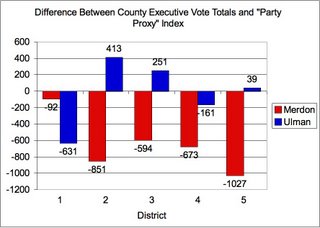In his first real splash as County Executive, Ken Ulman yesterday appointed a new director and deputy director for the Department of Housing and Community Development.
...Howard County Executive Ken Ulman announced yesterday that he's replaced the county's two top housing officials with his own choices. The firing of 15-year housing director Leonard S. Vaughan, 66, and 10-year deputy director Neil Gaffney, 60, mark Ulman's first moves to replace veteran county officials.
Stacy Spann, 33, of Fulton, an assistant commissioner in Baltimore's housing agency since March 2004, who rose from his teen years as a resident of Howard's Guilford Gardens public housing to live in Maple Lawn, will take over Howard's agency Jan. 15, Ulman said. ...Ulman chose Tom Carbo, 47, of Westminster, a 17-year veteran assistant county solicitor, county labor negotiator and Board of Appeals hearing examiner, as deputy director. Carbo began his new job immediately. Spann will earn $124,134, and Carbo's salary will be $110,573, according to Aaron Greenfield, Ulman's chief of staff.
The changes underscore the sensitivity of the housing issue in Howard, where the county government has struggled to promote units limited-income families can afford as home prices escalated beyond the reach of many working people. At the same time, some residents are increasingly opposed to even housing for people earning between $35,000 and $55,000 a year.
"Housing is a tough issue. Folks want affordable housing, but often times they have different thoughts about where it should be located," Ulman said.
...The new executive has otherwise moved cautiously, hiring a permanent police chief, a new budget director, and a chief administrative officer, all from within county government and without firing anyone. Ulman's predecessor, James N. Robey, a former county police chief who just completed two terms in the top job, didn't fire any appointed department heads when he took office in 1998.
...Ulman, a Democrat, said politics played no role in his decision. Vaughan and Gaffney are both Republicans who served under former executive Charles I. Ecker, a Republican, and Robey, a Democrat.
Ulman made the change, he said, because he wanted "a new director with a sense of creativity and vision" to work on the Affordable Housing Task Force report completed last month.
"As we work through that report, I thought it was very important to have a new direction, a new team in place with a sense of creativity and vision so that we can try to make sure that the policies we have in place are meeting the goals we have set out," Ulman said.
At the risk of stating the obvious, I wholeheartedly support Ulman's decision. And as I said elsewhere, my support has nothing to do with politics.
I’m sure Mr. Gaffney and Mr. Vaughan are great people, but the truth of the matter is that these guys have been running the housing department for over a decade and what do we have: a task force report saying the shortage of affordable housing in this county is somewhere between 20,000 and 30,000 (units). If we really want to make headway on the affordable housing issue, we’re going to need new ideas and energy. The same old same old hasn’t, and won’t, cut it.
Also, here's another good take on the appointments:
The Rev. Robert A. Turner, president of the African American Coalition of Howard County, said, "I think it's a positive move. You need someone not wedded to the status quo."
Much of what the housing department does is adminstrative stuff. It adminsters federal and state programs and funds for affordable housing. And with respect to these activities, I think Vaughan has done well.
But with a problem as large as ours, we need the department to be more active and proactive. And, unfortunately, a lot of what I've heard from Vaughan has been, as Turner said, defense of the status quo or, more accurately, a belief that our affordable housing shortfall is an endemic, intractable problem. See, for instance,
this post.
So, in addition to his youth (33!) and high school alma mater (Hammond High!), what else is there for me to like about Spann?
Spann is a former investment banker who moved to the non-profit housing field, Ulman said, as social investment officer for the F.B. Heron Foundation of New York, the Initiative for a Competitive Inner City in Boston and the Upper Manhattan Empowerment Zone Development Corporation.
Spann, who grew up in Alabama before moving to Maryland as a teen, became one of five assistant housing commissioners in Baltimore. City housing commissioner Paul Graziano praised him in a statement yesterday.
"Stacy Spann played a key role in this organization and his acumen, energy and enthusiasm will be sorely missed," Graziano said.
Spann said despite the lure of Wall Street, where he worked as an analyst, he was drawn to non-profit service.
"This is something I really wanted to do," Spann said about his career switch. "I want to use some skills to help revitalize a community."
A former investment banker giving up the riches of Wall Street to work in affordable housing?
Sounds familiar. But that's beside the point, which is in fact that Spann already has a lot of experience working in a range of capacities in the field and is clearly committed to the idea of affordable housing and the role it plays in helping people move up in society.
Also, his new deputy's credentials don't sound so bad, either.
Ulman said Carbo's experience would benefit the county.
"He really understands the nuts and bolts of the department," Ulman said, noting that Carbo drafted the law that created the Howard County Housing Commission, the county's primary agency for creating lower-priced housing.
The Sun has a couple other stories on affordable housing in today's issue, including
this one on the controversial Centennial-area proposal and
this one on why its so hard to get affordable housing built in Columbia (hint: because it's not part of the law).





